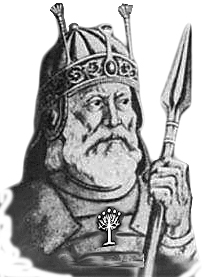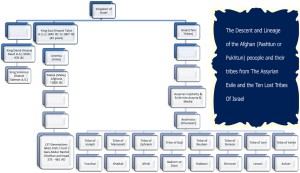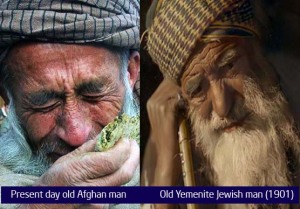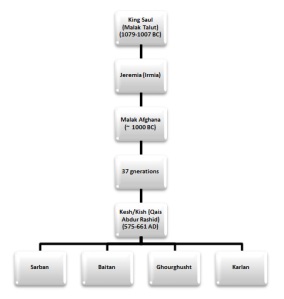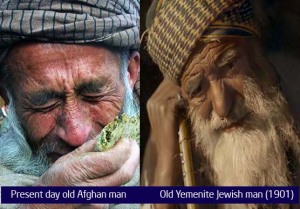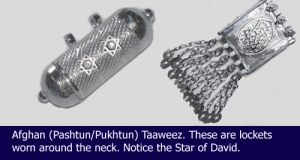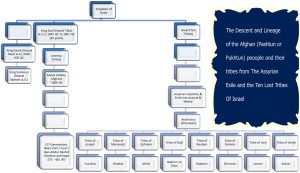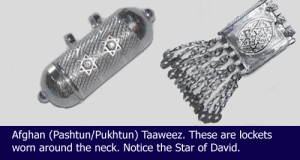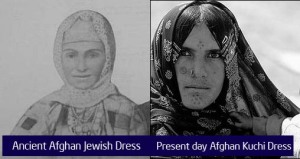Note: All references used are extensively given at the end for reference and consultation.Note: All references from books and texts used within the article are italicized and bulleted.Note: References will be continuously added for all the information provided in due time.Note: Information provided is from different eras, therefore for the information of the reader, some of these custom are now extinct...Oral Traditions

The personal identification of the Afghan (Pushtun) Tribes with their Israelite origin is expressed in various ways.
First of all, many Afghani people claim this to be so. Rabbi Avraham Hacohen, president of the Jewish community in the Afghan city of Heart (also Harath), testified that, he heard the former Afghani king Habib Allah Khan proclaim:
“I am from the tribe of Benjamin.”
In similar testimony, an immigrant to Israel recalls his childhood memory of King Habib Allah’s horseback tour of Herat:
“The Jewish dignitaries of the city gathered, among them my father. My father coerced me to join in greeting the king. The King asked the Jews, ‘What tribe are you from?’ ‘We have no tradition regarding that, so we don’t know, O King,’ answered the head of the delegation. ‘Well, we do know,’ said the king. ‘We, the Muhammad Zei family, are all descendants of the tribe of Benjamin from the seed of King Saul, from the sons of Yonatan Afghan and Pithon.’”
The former monarchy in Afghanistan has a widely-spread tradition according to which their origin was from the tribe of Benjamin and the family of King Saul. According to this tradition, Saul had a son called Jeremiah and he in turn had a son called Afghana. Jeremiah died at about the same time as Saul and the son Afghana was raised by King David and remained in the royal palace during the reign of Solomon too.

About 400 years later, in the days of Nebuchadnezzar, the Afghana family fled to the Gur region (Jat in our times). This is in central Afghanistan and here the family settled down and traded with the people of the area. In the year 622, with the appearance of Islam, Muhammad sent Khalid ibn Waleed to the 'sons of Ishrail' to spread the word of Islam among the Afghanistan tribes. He succeeded in his mission, returned to Muhammad with seven representatives of the residents of Afghanistan and with 76 supporters. The leader of these people was 'Kish' (or Kesh or Qais).
According to the tradition, the emissaries succeeded in their assignment and Muhammad praised them for this. He (the Prophet) gave the name Abdur Rashid to Kesh, announced that Kesh was from the Royal line of the House of Israel and that through his seed God will strengthen his religion.
- ["Lost Tribes from Assyria" by A Avihail and A Brin, 1978]
Many Pukhtun village elders claim this as well.
[youtube=http://www.youtube.com/watch?v=lbW2QMX7JxI]
VIDEO: They are ‘the seed of Israel,’ descended, they say, from Pithon of the tribe of Benjamin. Pithon, a great-grandson of King Saul, is mentioned among a list of hundreds of names chronicling the descendants of the Twelve Tribes
- [Chronicles I 8:35]
- [10. Chronicles I, 8:35]
- [Book of Samuel]
- [Hebrew Bible and Old Testament]
Other names of Afghani tribes resemble those of some of the Ten Lost Tribes of Israel: such as Rebbani/ Rabbani (Reuben); Levoni/ Levani (Levi); Ephriti/ Afridi (Ephraim); Yusuf Zai means Sons of Yusef (Joseph). The Ghaghi tribesmen claim their name is from Gad. Jewish names such as ‘Israel,’ are not used among the Muslims of any country except the Pashtuns. Jewish names have been seen on tombstones in far-flung graveyards around the country.
The great Torah Sage ‘Tiferet Yisrael’ wrote regarding the Ten Tribes:
“Many of the remaining became assimilated amongst the non-Jews.’

Regarding them is also the dispute between the Talmudic Sages Rabbi Akiva and Rabbi Eliezar, whether in the future those who remain but are assimilated will eventually be brought back to Judaism. For, although their identity as ‘Israel’ is forgotten, and the few Hebraic practices they have, are merely traditions handed down from their fathers, they themselves and many geographers consider them to be forgotten Jews.
- [Tiferet Yisrael, Perek Chelek]
- [Based on an article by Rafael Berelson]
A legend of the Pukhtuns, as recounted to Weil when she did field research among them in the 1980s along the Pakistani border, tells of "Jeremiah," son of King Saul
-- not the more familiar Jeremiah of the Old Testament -- who sired a child named "Afghana," and whose descendants along with the Assyrian Exile of Israel that never repatriated, the legend maintains, made their way to Media and to Arachosia (Khurasan) which is modern day Pakistan and Afghanistan, that still bears that name.
Many Pashtuns, Mashal pointed out, believe themselves to be descended from a legendary figure named Kesh (Hebrew Kish or Cush) or Qais (Arabized), a descendant of the Royal line of Judah and exiled into Ancient Khurasan, present day Afghanistan and Pakistan.
The legend states that this exile truly is descended from Pithon, a tribal descendant mentioned in First Chronicles, 8:35.
Almost every contemporary, academic or journalistic work, including —
Sir Olef Caroe’s The Pushtuns (or Pukhtuns), to the most recent histories of Afghanistan— mentions this oral tradition.
British colonial official
Mountstuart Elphinstone, writing in the early 19th century, compared Pashto to Hebrew in his book, The Kingdom of Caubul (also Kabul). Israel’s second president,
Yitzhak Ben-Zvi, believed in the Jewish lineage of the Pashtuns, as did
Zahir Shah, the last king of Afghanistan. Once, when asked about his ancestors, Shah claimed that the royal family descended from the Tribe of Benjamin.
According to Ilene R. Prusher:
Jews I spoke with who had grown up in Afghanistan also immediately identified with Pashtun-Jewish links. Their parents or grandparents, they would tell me, had always said, that of all the peoples living in current day Afghanistan, they could expect Pashtuns to treat them well on account of their shared Israelite heritage.
[youtube=http://www.youtube.com/watch?v=cD8P4kb_FGE]
VIDEO: Afghani Jews
Most of the researchers are therefore of the opinion that the origin of the Pathans is indeed Israeli. The aliyah to Israel of Afghanistan Jews and the volume of evidence heard from them on this subject about the customs of the Pathans corroborate this idea.
- ["Lost Tribes from Assyria" by A Avihail and A Brin, 1978]
Culture and Tradition
Accounts from Afghan Jews now living in Israel and researched done in this regard show considerable evidence. The evidence doesn't relate to all the Pathans or to all the tribes and places. However, it does prove the existence of Jewish customs among the Pathans. The research on this subject still requires significant work, both quantitative and qualitative.
Most of these customs have been forgotten, not practiced anymore and among the Afghans of Afghanistan & Pakistan only a handful remain and even then most of the Afghans remain un aware as to their origins. Some of the customs discussed include:
side lock, circumcision within eight days, a Tallit (prayer shawl) and four fringes (Tzitzit), a Jewish wedding (Hupah and ring), women's customs (immersion in a river or spring), levirate marriage (Yibum), honoring the father, forbidden foods (horse and camel food), refraining from cooking meat and milk, a tradition of clean and unclean poultry, the Shabbat (preparation of 12 Hallah loaves, refraining from work), lighting a candle in honor of the Shabbat, the Day of Atonement (Yom Kippur) prayer (some of them pray turned in the direction of Jerusalem), blood on the threshold and on the two Mezzuzot (in times of plague or trouble), a scapegoat, curing the ill with the help of the Book of Psalms (placing the Book under the patient's head), a Hebrew amulet (Kamia), Hebrew names (also. for neighborhoods and villages), Holy Books (they especially honor 'the Law of Sharif' which is the Law of Moses), and rising when the name of Moshe is mentioned.
- ["Lost Tribes from Assyria" by A Avihail and A Brin, 1978]
Lifting the bride and the groom by their friends at their wedding ceremonies is still practiced among the Khattaks, Yusufzai and Afridis of Pakistan, even to this day. A custom which among the Jews is practiced by Hasidim.

Family tree Scrolls
Besides the oral tradition related by the elders of the tribe, there are also interesting testimonies of keeping of scrolls of genealogy among the tribes, reaching back to the Fathers of the Jewish nation and ancient Judah.
There is interesting evidence about the preservation among the tribes of family trees on their origin, and on their relationship to the fathers of the Israeli people. These family trees are well preserved. Some of them are penned in golden lettering on deerskin. The names of the tribes speak for themselves: the tribe of Harabni (in the Afghan tongue) is the tribe of Reuben, the Shinwaree is Shimeon, the Levani - Levi, Daftani - Naphtali, Jaji - Gad, Ashuri - Asher, Yusuf Su, sons of Josef, Afridi - Ephraim, and so on.
- ["Lost Tribes from Assyria" by A Avihail and A Brin, 1978]
These scrolls, now almost extinct from the ravages of decades long wars, were well preserved and some are written in gold on the skins of a doe. No less interesting and significant are the names of the tribes which bear close resemblance to the Tribes of Israel. The Rabbani Tribe is really Reuben, the Shinwaree Tribe; Shimon, the Levani; Levi, the Daftani; Naphtali, the Jaji; Gad, the Ashuri; Asher, The Yusefzai; Joseph, and the Afridi Tribe; Ephraim. These are the names of the Ten Lost Tribes of Israel.
The Pukhtuns themselves point out the differences between the original names of the tribes and their present names are because of the different dialects of the languages so that, for instance, Jaji was actually called Gaji for the tribe of Gad and so on.
A family tree scroll found in Lund Khwar is particularly interesting. This is an area which was referred to by the Mughals as the Dasht e Yahoodi (The Jewish Waste/ moor or desert). This area has always remained a great center of the Afghans ever since their exile into Arachosia. Lund Khwar has been home to the three main Pakistan Afghan Tribes of Israelite origin, the Yusufzai, the Khattak and the Afridis. Scrolls belonging to the Yusufzai and the Khattak noble families of the area show their lineage from a grand ancestor even going as far into the past as Kish (Cush or) Qais Abdur Rashid (or Rasheed) during the lifetime of the Holy Prophet Muhammad P.B.U.H..
Sadly, like all of their other Bani Israelite heritage, these scrolls too are now a forgotten and do not exist anymore sans rarely.
Sabbath & votive candles
(relates information from a the 1980s, which is bound to have changed much since then)
Among the peoples and tribes living in the ancient Khurasan and parts of Pakistan and Iran, only the Pukhtuns have the custom of the Sabbath. Although changed and almost forgotten over the millennia of exile, some portents of the original still remain. The Sabbath is still considered a day of rest and they do not labor, cook or bake. Some Pushtuns still prepare a resemblance to the 12 Hallot (traditional Jewish bread, Leviticus 24:5) in honor of the Sabbath as was done in the ancient temple. One of the significant indicators proving the Israeli origins of the Pushtuns is the lighting of votive candles to honor the beginning of the
Sabbath, usually on Friday and mostly by rural folk. After lighting, the candle is covered usually by a large basket; this was the natural way to conceal their true origins from the strangers and nations among whom they live to this day. The candle is usually lit by the grandmother of the homestead or some other elderly lady.
This custom is common practice even today, both among the Eastern Pushtuns (Khattaks, Yusufzai, Afridis and others) and also the western Pushtuns (Ghilzai, Durrani/ Abdali etc.). However, as the region they inhabited came under the influence of Islam, this custom changed slowly over time, the true origins lost, and has now more or less transformed into the Muslim custom of lighting candles on the graves of saints and martyrs. However, there are still peculiarities that differ from the Islamic custom, for example, being lit only by the elderly women past their menopause, on Friday evenings and later being covered to conceal them.
Yom Kippur
(For the reader, some of these custom are now extinct)
Pukhtuns until very recent times had the custom of Yom Kippur. There are accounts of some of the members of the Levani Tribe who came to the Jewish synagogue on Yom Kippur each year in Afghanistan. They would stay there until sundown without uttering even one word. On being inquired about the origins of this, they spoke of the tradition of the Temple on this day and of the high priest and his work there.

Honor one's parent
The commandment to honor one's parent is kept in exemplary manner in these tribes. The son must obey the parents in all matters. When the father enters the room, all stand and bow their heads in his honor. This was an Israeli tradition as well.
Tallit (also called Saader or Kafan) and other cloths
The Pushtuns (or Pukhtuns) have a sort of small Tallit called Kafan, Saadar or chaadar in some parts and accents.

This is a 4 cornered garment which they tie strings similar to the fringes (Jews call them Tzitzit and Pushtuns call them Zundee or Zoondee) and is one of the oldest Jewish traditions going back to the Torah; a sign of their Israeli origin.
They also have a bigger Tallit which they call Saader or Ja’ iy-Nemaz. It is a garment 2-3 meters sq., and it is made to cover the head and part of the shoulders, and is used for prayer by spreading on the ground in the Muslim fashion. It usually has no fringes.
These can be regarded as the prayer shawls
similar to those of their Jewish counterparts in the West
- [Based on an article by Rafael Berelson]
Notice the similarity even to this day in the form of this article of clothing and its usage not to mention the fact that both the words Tzit Tzit and Tzunday sound similar.
Some of these cloths, in the olden days, in parts of Afghanistan and among the Yusufzai and Khattaks of Pakistan, were decorated with a symbol
that closely resembled the lamps lit by Jews at Hanukkah.
- [San Fran]
- [Ilene R. Prusher - The Christian Science Monitor, The Washington Post, The Philadelphia Inquirer, The New Republic and The Jerusalem]
- [Report: http://www.momentmag.com/]
Circumcision on the 8th day
(For the reader, some of these custom are now extinct)
The Pushtuns (or Pukhtuns) have the custom of circumcision on the 8th day. This is a known Jewish custom, and is the oldest Jewish tradition. Muslims have the custom of circumcision as well but it is not required to be necessarily on the 8th day.
Kosher Meat
(For the reader, some of these custom are now extinct)
Pushtuns (or Pukhtuns) have the custom of Kosher, dietary laws same as Jews, similar to the Halaal of Muslims but there are as usual, peculiarities. Pushtuns (or Pukhtuns) do not eat horse or camel meat, which is most common in their area, and common among the Uzbek, Tajik, Kazakh and other Mongol descended tribes, but of course forbidden to Jews.
Meat & Milk
(For the reader, some of these custom are now extinct)
There is some evidence to their not eating meat and milk together, which is also an ancient Israeli tradition. Various accounts of these are present, for example, among the Yusufzai and Khattaks of Mardan (part of Pakistan) and among others.
Pure & Impure birds
(For the reader, some of these custom are now extinct)
Pushtuns have a tradition regarding, differentiating between pure and impure birds which means permitted and not permitted birds similar to the Torah.
Scapegoat
The Pushtuns (or Pukhtuns) have custom of scapegoat. In ancient Israel there was the custom to put sins of the nation onto a goat or heifer and send the goat away to desert or out in the wilderness. This custom of scapegoat was done to atone the sins of the nation (Leviticus chapter 16). Similar custom is found even today among the Pushtuns (or Pukhtuns), e.g.: Among the eastern tribes (Yusufzai, Khattaks & others), western tribes (Ghilzai, Durrani & others) as well as, the Southern Tribes ( Kaakar, Sherani & others).
Periodical distribution of Land by Lot
There still exists among the Pushtuns, the tradition of the Periodical distribution of land by lot. This, in addition to other customs is present in the Book of Leviticus as heritage of the Bani Israel, and modern Muslim historians like Dr. Azmat Hayat Khan accept them as indicators, if not proof of their Israelite heritage. They are the only tribes in the area to practice all of these customs, as the ancient Bani Israel did 2,300 years ago.
- [Dr. Azmat Hayat Khan, The Durand Line-it’s Geo Strategic Importance, (Islamabad: Area Study Centre, University of Peshawar, 2000) p. 30, 34]
- [http://wakeupproject.com/forum/]

Tefillin (phylactery) & Pushto Torah
(For the reader, some of these custom are now extinct)
(For the reader, this para is related to the Afghans during the 19th century, though a similar article called the Taaweez is still used today)
Some, still wear a small box known to Jews and rabbis as the Tefillin (phylactery), containing a verse of the Holy Book. This is an ancient custom of Israel.
The original ancient Jewish box had the verse of Shema Israel, that is:
"Hear, O Israel: The Lord our God, the Lord is one!"
This custom of Tefillin came from a verse of the Scriptures,
"You shall bind them as a sign on your hand, and they shall be as frontlets between your eyes"
However, today, except for a few far flung rural communities in Northern Afghanistan (Taloqan etc.), this tradition is more or less extinct.
However with the advent of Islam, a modified form of this tradition exists in the form of apparels called Taaweez. These are small metallic boxes that contain verses of Unity and Glory of Allah (Arabic name for YHWH). Interestingly, many of these Taaweez both in Afghanistan and Pakistan bear the symbol of the Star of David.

Pic: Afghan Pashtun Pukhtun Taaweez with Star of David
Many accounts and documents still exist relating to the Pushto version of the Torah, written by ancient Pushtun rabbis and religious scholars.
In particular, the Yusufzai and Khattaks of Mardan, Sawabi and Swat are mentioned in several scholarly works of possessing such ancient manuscripts. Pushto Torah
Family names of the Lost Tribes
It is interesting to note that the Pushtuns (or Pukhtuns) retain family names of the Lost Tribes such as Asher, Gad, Naphtali, Reuben, Manasseh and Ephraim. Among them there are people who are called by these names, which are of the Ten Lost Tribes of Israel. However, the original names or accounts regarding some of these tribes such as the Khattaks has been lost forever.
No less interesting and significant are the names of the tribes which bear close resemblance to the original Tribes of ancient Israel. Some tribes with visible similarities with Hebrew names are:
Yousuf Zai – Sons of Joseph
Gadoon – Gad (also Jaji – Gad)
Rabbani – Reuben
Abdali or Naftali – Naphtali ( also Daftani – Naphtali)
Shinwari – Simeon or Shimon
Zamand - Zebulun
Levani – Levi
Afridi – Ephraim
Ashuri - Asher
Pathan – Pithon
The Pushtuns (or Pukhtuns) themselves point out that the differences between the original names of the tribes and their present are because of the differences in dialect, accents and local languages, so that, for instance, Jaji was actually called Gaji for the tribe of Gad and so on.
Yusuf means Joseph and Yusufzai means children of Joseph. They also call themselves Bani-Israel meaning children of Israel. Their tradition is that they were carried away from their ancient homeland, and through the ages eventually settled into what is now Pakistan, Afghanistan and some other countries.
Similarly many Hebrew inspired names of people, tribes and places are commonly found among the Pashtuns and Pashtun areas of Pakistan/Afghanistan.
Peculiarities and paradoxes
It is a known fact among the Pushtuns and most historians that, of the all Pushtun Tribes, the ones with known descent from the four sons of Kesh are the actual descendants of Kesh (Kish) or Qais, and therefore descendants from the line of the kings of ancient united Israel. Kesh (Kish) was from Judah and later exiled into ancient Assyria, Persia (ancient Khurasan) and later into current day Afghanistan and Pakistan.
However, it is also a known fact that, whereas, some of these tribes retain their original names more or less, others do not. For example, the youngest son of Kesh had seven sons, and his descendants are as follows:
Karlani or Karlanri > Mehsud, Wazir (or Waziri), Khattak, Afridi, Orakzai, Daawar, Bangash.
As we can see, the Afridis share the same descent with the Mehsuds, Wazirs, Kattaks and the rest. Of these, the closest in descent to one another are the Afridis and the Khattaks. However, whereas the Afridis claim to be descended from the Ephraim, the original ancient tribe name for the Khattaks has been lost forever. This could most probably be because the Khattaks represent a new tribe that took shape from the Afridis and the Yusufzai. From The ancient home of the Khattaks after their eastward migration from ancient Afghanistan into present day Pakistan is a city named Kerak, surprisingly similar sounding to the ancient Kerak. Though many Khattaks reside today as far north east as Mardan, Sawabi and Peshawar but the occurrence of this Hebrew name with no other plausible origin is interesting in its own right.
Note
Though many Afghans consider Qais (Kish) as their unified grand father or progenitor, the reality of the matter is that, Kish was only the selected leader of the Afghan delegation which traveled to Medinah to meet the Prophet Muhammad. He was therefore their chieftain at the time. This delegation is said to have comprised of 76 people representing all Afghan tribes.
Some scholars suggest that, of these, the Waziris, are actually the Naaziri of ancient Israel, since among other things, both have the custom of letting long hair.

Israeli Tradition in Afghan Royal Family
The Afghan Royal Family has a well known tradition placing its origin in ancient Israel, they came from the Tribe of Benjamin.
First of all, many Afghani people claim this to be so. Rabbi Avraham Hacohen, president of the Jewish community in the Afghan city of Harath, testified that he heard former Afghani king Habib Allah Han proclaim, “I am from the tribe of Benjamin.” In similar testimony, an immigrant to Israel recalls his childhood memory of King Habib Allah’s horseback tour of Harath (Herat): “The Jewish dignitaries of the city gathered, among them my father. My father coerced me to join in greeting the king. The King asked the Jews, ‘What tribe are you from?’ ‘We have no tradition regarding that, so we don’t know, O King,’ answered the head of the delegation. ‘Well, we do know,’ said the king. ‘We, the Mahmad Zei family, are all descendants of the tribe of Benjamin from the seed of King Saul, from the sons of Yonatan Afghan and Pithon.’”
- [Based on an article by Rafael Berelson]
The former monarchy in Afghanistan has a widely-spread tradition according to which their origin was from the tribe of Benjamin and the family of King Saul. According to this tradition, Saul had a son called Jeremiah and he in turn had a son called Afghana. Jeremiah died at about the same time as Saul and the son Afghana was raised by King David and remained in the royal palace during the reign of Solomon too. About 400 years later, in the days of Nebuchadnezzar, the Afghana family fled to the Gur region (Jat in our times). This is in central Afghanistan and here the family settled down and traded with the people of the area. In the year 622, with the appearance of Islam, Muhammad sent Khalid ibn Waleed to the 'sons of Ishrail' to spread the word of Islam among the Afghanistan tribes. He succeeded in his mission, returned to Muhammad with seven representatives of the residents of Afghanistan and with 76 supporters. The leader of these people was 'Kish' (or Kesh or Qais). According to the tradition, the emissaries succeeded in their assignment and Muhammad praised them for this. He (the Prophet) gave the name Abdur Rashid to Kesh, announced that Kesh was from the Royal line of the House of Israel and that through his seed God will strengthen his religion.
- ["Lost Tribes from Assyria" by A Avihail and A Brin, 1978]
Hebrew personal names
The occurrence of pure Hebrew names among the Pushtuns is common place, even though; such names being those of the ancient prophets of Israel, and common to both Jews and Muslims are nowhere to be found among other Muslims. Of these, the specifically Pushtun kept include, Israel, Zabul (from Zebulon or Zabulon), Afghan (Afghana), Amran etc.
Similarly, whereas other Muslims usually prefer names of the Prophet Muhammad and his companions, the usage of more Hebrew prophets is predominant among the Pushtuns. Hebrew names that are thus commonly used both by the Pushtuns and other Muslims include: Salman (Persian version of Shlomo or Solomon), Musa (Moses), Ibraheem (Avraham), Aazar, Yaqoob (Jacob), Yusef (Joseph), Shoaib (Jethro) etc.. One name, exclusively Pushtun is Natha; as in Natha paired with Khan, which may have its origins in the same root from which Nathan is derived.
Hebrew place names
There are also many Pushtun areas & locations, neighborhoods and villages, with names reminiscent of ancient Israel, the Torah and Hebrew origins. Infact, these are so common place and in all the regions of the Pushtuns (a great region spread over many countries and thousands of square miles) that their occurrence only in the Pushtun homeland and in all its entirety is more than pure coincidence.
The mountains the Pathan’s have been living in after the exile, are called by them, the Suleiman (Solomon) mountains.
The popular places that trace their origin in Hebrew include:
- Koh-e-Suleiman – Solomon Mountains
- Takht-e-Suleiman – Throne of Solomon (the highest peak in the Solomon mountains)
- Afghanistan – Afghana (the grandson of King Saul)
- Kohat – or Kohath, a city in NWFP, Pakistan, means assembly in Hebrew and it is also the name of the second son of Levi and the father of Amram or Amran.
- Zabul – A province in present day Afghanistan and in the days of Mahmood Ghaznavi the whole region of Afghanistan was known as Zabulistan – Zebulon was one of the sons of Prophet Jacob (AS).
- Khyber – a place near the Pakistan/Afghanistan border. In the time of Prophet Muhammad PBUH, Khyber was an ancient Jewish Citadel city near Yathrab (present day Medina).
- Peshawar – The Capital of NWFP province of Pakistan – PESH means the Pass and HAWAR means City i.e. The City after the Pass. Peshawar is a short drive from Khyber Pass. A Place named Habor or Havor is mentioned in Torah as the place of the exile of the tribes. The city of Havor is, they say, peh-Shauor (Pash- Havor') which means 'Over Havor'.
Biblical Origins of the name
According to the Bible
- [Kings 02:17:06, Kings 02:18:11, Chronicles 01:05:26]
- [<ref>http://av1611.com/kjbp/]
The ten tribes were exiled to Halah and Havor and the river Gozan and to the cities of Maday. According to the tradition of the Jews of Afghanistan and old Afghan historical texts, the river Amu in entirety was called Gozan. Therefore Historian Saadia Gaon states:
- [http://en.wikipedia.org/wiki/Saadia_Gaon]
“ River Gozan ” is the river north of the city of Balach in the north of Afghanistan. The river is known today as the “ Amu Darya ”, and is the border between Afghanistan and Russia. Afghanistan tradition states that the whole river was once known as the Gozen River.
“Habor” is located in the pass between Afghanistan and Pakistan , and is called Pesh-Habor in Afghani (Pesh means Pass) after the city of the pass. The city is known today as Peshawar.
“Hara” is the city of Harat near the Persian border. It is the third largest city in Afghanistan . The prophecy of Isaiah states that the exile will bring the tribes to the land of Sinim”:
“Behold , these shall come from far, and , lo, these from the north and from the west, and these from the land of Sinim “( Isaiah 49:12).
Rabbi Benjamin of Tudela
- [http://en.wikipedia.org/wiki/Benjamin_of_Tudela]
In the year 1165, about 300 years after the travels of Eldad Hadani, Benjamin ben Jonah departs from Tudela on a journey in search of Jewish communities. In 1171 he returns to Spain and writes his memoirs, the famous "Journeys of Benjamin of Tudela."
Regarding the tribes of Dan, Zevulun, Asher and Naftali he writes: "…And it is said that in the Nasbor cities there are four tribes of Israel, Dan, Zevulun, Asher and Naftali… and the distance of their land is twenty days, and they have provinces and cities. On the one side they are surrounded by the river Gozan, and the yoke of the non-Jews is not upon them, and among them are scholars, and they sow and reap and go to war in the Land of Cush through the deserts."
The area describes by Rabbi Bejamin, as the home of the Ten Tribes, is a mountainous area, divided by steep valleys. The cities of Nisbor are found in northeastern Iran, close to the border with Afghanistan.The and of Cush meaning Kish or Zhob where Kish (Qais abdur Rashid) lived and died.
Rabbi Saadia Gaon in the 9th century and Moshe ben Ezra in the 11th century mention Afghanistan - then known as Khorasan - as the home of the Ten Tribes.
- [http://www.kosherica.com/10lostTribes/index.asp]
- [Lost Tribes from Assyria" by A Avihail and A Brin, 1978]
Gozan
The historical name of Amu River in Afghanistan, hence the Torah says: “The God of Israel stirred up the spirit of Pul King of Assyria, and the spirit of Tilgath Pilnesser King of Assyria, and he carried them away, even the Ruebenites, and the Gadites, and half the tribe of Manasseh, and brought them to Halah, and Habor, and Hara and to the river of Gozan to this day.” (Kings II, 17 and 18; Chronicles 1:5:26).
Kerak
A City in Jordan and another in NWFP, Pakistan, the ancient home of the Khattak tribe.
Logar
A province in Afghanistan and a localized form of a famous Jewish family name.
Kabul
in Hebrew Cab means dirty and Bul means city hence a dirty city, whereas others suggest, it means Cain and Abel.
Herat
The pearl of Khurasan – a city in Afghanistan, Hara is one of the places of the exile along with Habor and Gozan.
Kash/Kish or Kesh
Name of numerous personalities in Chronicles of Hebrew Bible – and a Dasht-e-Kash north of Helmand, a City of Kash mentioned in map of Afghanistan 1912 of the Library of Congress. There is also a Kash Rod in Nimroz Province of Afghanistan.
Dasht-e-Yahoodi
– or the Jewish Plain – a famous place in Mardan district of NWFP, Pakistan.
Killa Yahoodi
– or Jewish Fort – a place on Afghanistan Pakistan border.
Archeological finds
The region has several archeological sites pointing to a Hebrew origin.
Some of these include:
Gardez
which has ruins of an ancient fortress built by a famed Israelite warrior named Gabur.
Ghazni Province
where Pashtuns make pilgrimages to the tomb of an ancient “Hebrew (Ancient Afghan) saint” called Zikria;
Balkh Province
an ancestral area with many ancient ruins and which once boasted a large Jewish population mentioned in several contemporary Arabic Historical Chronicles.
The Pushtuns (or Pukhtuns) usually pray in mosques. However there are many old synagogues scattered throughout Afghanistan. Abandoned today, these were well respected and adored till modern times. They contained scrolls of the Torah, some of which existed till the late 1940s.

Apart from synagogues, Sifrei Torah, Hebrew place names and tribal family trees, there also exists evidence on important archeological finds: near the town of Herat in Tchcharan, old graves were found on which the writing was in Persian and in the Hebrew language. The graves date from the 11th to the 13th centuries. In an opposite fashion, so it seems, there are a number of inscriptions engraved on rocks in ancient Hebrew script near the town of Netchaset and Mardan (Pakistan). In the 'Dar el Amman' museum in Kabul, the capital of Afghanistan, there is a black stone found in Kandahar, on which is written in Hebrew with a similar one found in Mardan (Pakistan.
Mr. Chiya Zorov of Tel Aviv notes:
When the Bolsheviks rose to power in Russia, they divided the large area of the southern part of central Russia into smaller districts such as Tajikistan, Turkmenistan, Kazakhstan, etc. In Tajikistan, is located the city of Dushanbe. It started to develop and grow during the period when Stalin gained power and many Jews then began to stream into Tajikistan. They found that the tribes there once in contact with the Bukharan Jews light candles on Friday evening and eat a dish made of meat stuffed with rice called Pacha, which is characteristic of the Bukharan Jews and is eaten on Friday night. It is known widely that the Bukharan Jews migrated from what is current day Afghanistan.
Rabbi Saadia Gaon discussed at length with the Hacham Hivay Habalchi and in the opinion of the speaker, in that period (10th century) the Jews were inclined to assimilate into Islam and it was about this that they were arguing. The scholar Ibn Sina, born in Bukhara, also lived at the time. The teacher Tajiki said that he, too, belongs to the Jews who converted into Islam and are called Tchale. As recounted, the meaning of his name is Even Sina - son of Sina (and up to this day in many languages, and also in Hebrew, the words are similarly pronounced - Sinai, Sin Sina) and perhaps this is why he called himself Ben Sinai, in other words, son of the Torah which came forth from Sinai.
Nawab Hoti of Mardan
The Nawab Hoti of Mardan (near Peshawar) was a scholar who completed his studies at the University of London. He also visited a Jewish man called Carmeli, who contributed with Mr. Hiya Zorov in scholarly work. The Nawab Hoti, a researcher on the Origins of Pushtuns from the Israelites was of the opinion that Pushtuns of Pakistan and Afghanistan were once Jews. The Nawab also published a book on this subject called “The Israeli descent of the Afghans”. In the book, the Nawab cites from the Yusufzai, Khattak and other Pushtun tribe elders of their ancient tradition that they are among the people of the First Temple from the Ten Tribes, who of Assyrian exiles settled first in current day Afghanistan and Pakistan. Afterwards they were joined by the Jewish exiles from the Second Temple Exile.
- [Translated from Hebrew by Issachar Katzir, from "Lost Tribes from Assyria" by A Avihail and A Brin, 1978.]
Stones on Graves
There is a Pushtun customary tradition of placing stones on the graves of one’s loved ones. Even today, one may find stones scattered on nearly every grave in the Pushtun cemeteries in both Pakistan and Afghanistan. This is a peculiar Pashtun way of marking a visit to the deceased. This custom however, is not found among any other of the nations in Pakistan or Afghanistan. Travelling through the region, one may not come across any other people but these who prefer pebbles over flowers on a loved one’s grave.
- [Ilene R. Prusher - The Christian Science Monitor, The Washington Post, The Philadelphia Inquirer, The New Republic and The Jerusalem]
- [Report: http://www.momentmag.com/]
Features
Racial features vary among the Pushtuns, since, throughout time, the original Pushtun cast has mixed and mingled with the different Nations and Armies passing through. Therefore, among the Pushtuns, one may find both true Semitic or Arabian features, as well as Aryan features. The majority of the Pushtuns possess features which may be likened to a Middle Eastern or Iranian origin, for example the Yusufzai, Khattak, Durrani etc. There are among them tribes for example Nooristanis, Afridis, Niazis etc. with racial features more likened to Aryans, Punjabis and other peoples.
Some accounts related to this subject are as follows:
Dr. Joseph Wolff says:
I was wonderfully struck with the resemblance of the Yusufzai (sons of Joseph) and the Khyberi (Afridis, Shinwaris and Khattaks) to the Jews”.
- [Rev. Joseph Wolff, D.D. LL.D, Narrative of a Mission to Bokhara in the years 1843-1845]
- [John W. Parker, London, 1845). Vol. 1 2nd Edition. P. 17.]
Moorcroft also says of Khyberis(Afridis, Shinwaris and Khattaks):
They are tall, and of singularly Jewish cast of features… they have been named by themselves Bani Israel, children of Israel from time immemorial.
Missions and travelers to Afghanistan in the British colonial era have stated how they resembled the Jews of the area and to some extent their language. The British missions to Afghanistan used to call them Jews, and that, when not wearing their traditional clothing Pushtuns (or Pukhtuns) are indistinguishable from other Jews of the area. Among the 21 nations of Afghanistan only the Pushtuns (or Pukhtuns) and the Jews have Semitic features, their faces are longer and lighter, and some even have blue eyes.
Colonel G. Malleson of the British Army did not believe that the Afghans were Bani Israel, but commented on the issue of physical features:
This no doubt has its weight
- [History of Afghanistan by Colonel G. Malleson, C.S.I. (W.H. Allen & Co, London, at the India Office, 1878), p 39.]
“Even when he leaves his native heath behind he takes his manner with him. He will come down, a stalwart manly looking ruffian with frank and open manners, rather Jewish feature… He is certain to be filthy and he may be ragged, but he will saunter into a viceregal durbar (Royal court) as proud as Lucifer and with the air and manner a diplomatist might envy. Not in the least like any Indian subject.”
- [Oliver, Across the frontier, Pathan and Baluch (London: Champman and Hall Ltd., 1890) p 224]
Pakhtun Physical features: The Historians opinion
Racially, there is a considerable difference between the various Afghan tribes. The Pathans of Bajaur are closely related to the Kalashes of Citral, probably because they are to a large extent Afghanized Dards. On the other hand the broad-headed Pathans of Balochistan resemble their Baluch neighbors. In the plains of Peshawar there is some admixture of Indian blood, and among the Ghilzai tribe of Afghanistan there are traces of Turkish influence. But in general it may be said that the Afghans belong to the Irano-Afghan branch of the dolichocephalic Mediterranean race. The skull index is 72-75, and the average height 170 cm. (Hill tribe Pathans), and 163 cm. (Afghans of Afghanistan). The nose is prominent, frequently convex, of the "Semitic" type. Similar noses are found also among Balochis and Kashmiris. "The Afghans are usually brunets (black haired), but at the same time show a persistent minority of blondism, which may reflect some Nordic admixture.
They are heavy-bearded".
A recent book by Dr. Azmat Hayat Khan sums up the physical characteristics:
The Pathans of the hills are usually tall, fair skinned and have ivory complexions
Kashmir was under direct control of the Durrani Afghan Empire in the 1800s, and the majority of the population there were the Yousufzai Pakhtuns who had moved eastward from Peshawar. They were living in Kashmir in great numbers, about 600,000 families who were later forcibly subdued for about 40 years by the Sikhs.
Dr. Bernier, A French traveler in the frontier villages of Kashmir around the 1880’s remarked on the striking physical similarity of the locals with Jews. He noted that their expressions and manners were distinguishable from the other people in this land. He finally adds that:
You are not to ascribe what I say to mere fancy, the Jewish appearance of these villagers having been remarked by our Father, the
Jesuit, and some other Europeans long before I visited Kashmir”.
The Jesuit Dr. Bernier points to is Dr. Joseph Wolff who says:
“I was wonderfully struck with the resemblance of the Youssoufszye (sons of Joseph) and the Khyberi, two of their tribes, to the Jews”. Moorcroft also says of Khyberis “They are tall, and of singularly Jewish cast of features… they have been named by themselves Beni Israel, children of Israel from time immemorial.”
Bernier was also referring to George Forster who wrote in 1808:
“On first seeing the Kashmirians in their own country I imagined from their garb, the cast of their countenance which was long and of a grave aspect, and the forms of their beard, that I had come among a nation of Jews”.
Colonel G. Malleson of the British Army did not believe that the Afghans were Beni Israel, but commented on the issue of physical features:
“This no doubt has its weight”.
- [Bani Israel in Pakistan; The Israeli History of the Pathan Tribes by Qazi Fazli Azeem.]
- [B. S. Guha, Census of India, 1931, i, iii A, p. xi]
- [Coon, Races of Europe, p 419[4] Coon, Races of Europe, p 420]
- [Dr. Azmat Hayat Khan, The Durand Line-it’s Geo Strategic Importance, (Islamabad: Area Study Centre, University of Peshawar, 2000) p. 31]
- [William Jesse, History of the Afghans, (Lahore: Sang-e-Meel Publications, 2002) p. 8.]
- [An English translation of the French Caravan Journeys by General J. P . Ferrier (1st Regiment of Chasseurs D’Afrique, 1845).]
- [François Bernier “Travels in the Moghul Empire” (Constable, London, 1891, Pg. 930-932).]
- [Rev. Joseph Wolff, D.D. LL.D, Narrative of a Mission to Bokhara in the years 1843-1845, (John W. Parker, London, 1845). Vol. 1 2nd Edition. P. 17.]
- [George Forster, Letters on a journey from Bengal to England. (Faulder,London, 1808) (Vol. II, page 20).]
- [History of Afghanistan by Colonel G. Malleson, C.S.I. (W.H. Allen & Co, London, at the India Office, 1878), p 39.]
Pakhtun Physical features: Oral Tradition
By their own historical tradition, the Pakhtun tribes are descended from the Israelite tribe of Benyamin, specifically from King Saul’s children. This will explain their unnatural tall height which is uncharacteristic of Jews in the middle-east. King Saul is known in the Quran as “T alut”, which means “T all” in Arabic. In the T orah, specifically in the Book of 1 Samuel, Saul is described as an unusually tall and handsome man. In this context, the Pakhtun tribes are amongst the tallest people in the area and were known to Mahatma Gandhi’s India as the “mountain giants”. Lord Curzon, the British viceroy to India commented about them:
“I know these men. They are brave as lions, wild as cats, docile as children…It is with a sense of pride that one receives the honest homage of these magnificent Samsons, gigantic, bearded, instinct with loyalty, often stained with crime”.
Pakhtun (Pathan) features are well shaped and good looks are common, as can be compared to their alleged progenitor, King Saul of Israel.
- [Ekhnath Easwaran, Badshah Khan, (New Delhi: Penguin Books, 2001) p 64.]
- [Dr. Azmat Hayat Khan, The Durand Line-it’s Geo Strategic Importance, (Islamabad: Area Study Centre, University of Peshawar, 2000) p. 31]
- [Bani Israel in Pakistan; The Israeli History of the Pathan Tribes by Qazi Fazli Azeem.]

Pakhtun Emotional Characteristics: Israeli history
Saul’s entire reign as the first King of the Beni Israel was marked by a religious tilt, and Israeli historians comment on his strict observance of religious obligations, as for instance in the case of Jonathan and the altar-stone of Aijalon, and in depicting him as possessed from time to time by the spirit of Jahweh.
On his campaigns he took with him a priest who was expert in the use of the ephod, and did not fail to consult him. An entirely probable tradition relates that he prohibited those who consulted the dead and familiar spirits. If he condemned these practices, it must not be supposed that he considered them fraudulent; on the contrary, it was because he regarded the spirits of the dead and the spirits of the elohim as rivals of Jahweh, the sole God of Israel.
Saul’s intensely religious character is reflected in the Pakhtun tribes, which spawned the Taliban, the former regime of Afghanistan widely condemned for their ‘extreme’ interpretation of Islam.
Many historians have reconfirmed that the Pakhtuns are in no way a united people. They have many sub clans and are constantly feuding with each other. Nothing except the danger of a common enemy can unite them.
This is a direct reference to the Beni Israel tribes which united under King Saul only to fight the common Philistine enemy. Israeli Jews today write in their own words:
“Israelis have long joked that the surest way to destroy the country is for the Arabs to give it peace. Then the tensions within Israeli society would pull it apart”.
- [Adolphe Lods, Israel: From its Beginnings to the middle of the 7th Century, (Wiltshire UK: Routledge, 1996)]
- [1 Sam. xxviii. 3, 9]
- [Dr. Azmat Hayat Khan, The Durand Line-it’s Geo Strategic Importance, (Islamabad: Area Study Centre, University of Peshawar, 2000) p. 34]
- [Christopher Dickey and Daniel Klaidman, How will Israel Survive, Newsweek (New York: April 1,2002) p 16.]
Side Locks (Peot)
(For the reader, many of these customs and ways are now extinct)
Like the Jews of the area, Pushtuns (or Pukhtuns) grow beards and in old times, side locks which further served to make them indistinguishable from Jews. However, today, though the beards are still common among them, the side locks are no more to be found.
The Pathans are quite strict about not shaving their sidelocks (peot), which is in accordance with the Torah command, ‘Don’t shave the sides of your head’ (Leviticus 19).
- [Based on an article by Rafael Berelson]
- [San Fran]
Amultes or Taweez
Amulets written in Hebrew. Some contain the phrase "Shema Israel" and it is secretly written by the head of the tribe and it is forbidden to open it.

However, these days, it has been replaced by Taweez. These usually contain the Ayat ul Kursi which is a verse about the Glory and Power of Allah (Arabic for YHWH).
Interestingly, many of these have the Star of David which is also the symbol of the seal of Solomon etched or imbued on them.
.
.
Symbols; Star of David (The Shield)
And the symbol of Shield of David (Star of David) is found in almost every Pathan house. The wealthy make it out of expensive metals and the poor out of simple wood. It can be seen in towers, in schools and also in tools, bracelets, and jewelry. I saw it at least 20 times in a variety of places. In Minerajan, the center of Afghanistan, there are even schools that have the Shield of David on the door or in the stone above the door.
the Star of David symbol is prevalent in almost every Pathani home! The great Torah Sage ‘Tiferet Yisrael’ wrote regarding the Ten Tribes: ‘Many of the remaining became assimilated amongst the non-Jews*.’
- [Based on an article by Rafael Berelson]
Symbols; Menorah and Nars
Less than an hour later, we passed through a typically poor village on the road back toward Kabul. Paint markings on some of the buildings caught my eye. They resembled five-branch menorahs. I asked Mashal what they were.
“Oh, we call it nars,” he replied. “People in the countryside put this up to mark a celebration, such as a birth or wedding.”
“Do all the peoples in Afghanistan do that, or just the Pashtuns?” Iasked.
“This is only for the Pashtuns,” he said.
It seemed uncanny. Menorah…nars. They sounded as if they shared the same root. And unlike the Star of David, which did not originate with the Jews, the menorah symbol had never belonged to another people.
- [Ilene R. Prusher - The Christian Science Monitor, The Washington Post, The Philadelphia Inquirer, The New Republic and The Jerusalem]
- [Report: http://www.momentmag.com/]
Other Symbols
(Some of these remain though usually not used in a Hebrew sense, whereas others are now extinct)
Likewise, if anyone travels in the local bus transport of the Pakistani Pashtun areas, he or she would see fascinating art works in their buses but strikingly all these art works have Israelite origin, these peculiar diagrams include:
1. Peacocks (Torah was written with peacock feathers)
2. The Symbolic ark
3. The Mogen David or the Star of the David – also found in the Israeli flag
4. Tree of Life of Kaballah
5. Fish of the Sabbat/Shabbos
6. The heart shape lamp of the Sabbat
7. Number of Leaf petals signifying Kaballah practices.
Language
Pashtu surprisingly has many Hebrew words.
Self Name
The Pushtuns (or Pukhtuns) are also called Afghans, or sons of the Pashtu which is their language, were mostly called "Bani-Israel" meaning children of Israel even though they live today as devout Muslims.
Pushtunwali (Pushtuns (or Pukhtuns)' Law) Resembles the Torah
The legal system which is known as Pashtunwali, the law of the Pashtu, is very similar to the Torah, which is the holiest Jewish book and the book of ancient Jewish way of life. There are pages and even complete books among the Pushtuns (or Pukhtuns) and they honor greatly what is called Tavrad El Sharif (the Torah of Moses), and they rise at the mention of the name of Moses even though it is not important in Islam.
Hospitality
They are warriors and carry arms from a young age, they are hardworking, wise, truthful and extremely loyal and they also have a worldwide reputation for exemplary hospitality.
Weddings
Their wedding is like Jewish. Wedding ceremony with the Pushtuns (or Pukhtuns) includes a marriage canopy and rings similar to the Jewish custom. There are wedding customs: Some Afghans marry under a cloth that is similar to the chuppa.
- [Ilene R. Prusher - The Christian Science Monitor, The Washington Post, The Philadelphia Inquirer, The New Republic and The Jerusalem]
- [Report: http://www.momentmag.com/]
Levirate marriage
Pushtuns (or Pukhtuns) have custom of levirate marriage, which is the custom when a husband dies without children, his brother marries the widow to keep the name of the house. This custom no longer exists today, but was an ancient Israeli custom mentioned in the Bible

Women
Women of the Pushtuns (or Pukhtuns) keep laws similar to the Jewish laws regarding menstruation. During this time and for 7 days after, no contact is allowed with the husband. After this period, the woman immerses in a river or spring or in a bathhouse if a natural spring is not available. This is exactly the same as the Israeli tradition going back to the days of the Bible.
In plague outbreaks
“Passover Practice” of sacrificing an animal and smearing the doorway to avert death and calamity
2. Placing the sins of the people upon a heifer or goat which is driven out in the wilderness in the manner of the biblical scapegoat
3. Stoning to death of blasphemers
4. Periodical distribution of land by lot (17)
At the time of plague the Pushtuns (or Pukhtuns) slaughter a sheep and sprinkle its blood on the doorpost of their homes. This is what the Israelites did in ancient Egypt during the plagues that occurred there.
In Illness
An interesting testimony relates to the placing of a wrapped book of Psalms of the Bible under the pillow of the ill in order to heal that person.
Conversion to Islam
This tradition was first published in 1635 in a book called Mahsan-I-Afghani and has often been mentioned in the research literature. According to this tradition, King Saul had a son called Jeremiah who had a son called Afghana. Jeremiah died at about the time of King Saul's death and Afghana was raised by King David and remained in the royal court during King Solomon's reign.
About 400 years later in the time of disorder of Israel, the Afghana family fled to a land called Gur which is in central Afghanistan. They settled and traded with the people of the area and in the year 662, with the arrival of Islam, the sons of Israel in Gur converted to the prophet with 7 representatives of the Afghan. The leader of the sons of Israel was Kish like the name of Saul's father.
According to this tradition Muhammed rewarded them and Kish's Hebrew name was changed to Arab-A-Rashid by Muhammad and was given the task of spreading Islam among his people. This is the roots of Afghan Royal Family.
So Afghan Royal Family has the tradition of ancient Israel - Benjamin Tribe of the Southern Kingdom of Judah.
Another book, Taaqati-Nasiri, states that in the 7th century, a people called Bani Israel settled in Ghor, southeast of Herat. According to Taaqati-Nasiri as well as Pashtun legend, the Bani Israel soon accepted Islam, after their leader, Qais, met with the Muslim Prophet Mohammed.
References used for this article
(All of these reference books were consulted and utilized for this article but were not mentioned at every single point taken from these texts due to the cumbersome nature of this article. However it is advised to read them all for further reference and for actual source and facts from the authors.)
- [W.M. Jr. Thackston, The Baburnama: Memoirs of Babur, Prince and Emperor, Modern Library; Modern Library Pbk. Ed edition (September 10, 2002)]
- [Al-Asha-ah, Page 240 also Page 108 of “Islam main Imam Mehdi Ka Tassawar” by Maulana Professor Muhammad Yousuf Khan, Jamia Ashrafia, Lahore, Pakistan]
- [Book 041, Number 6979, Sahih Muslim]
- [Page 215, Kitab-al-Fitan and Page 108 of “Islam main Imam Mehdi Ka Tassawar” by Maulana Professor Muhammad Yousuf Khan, Jamia Ashrafia, Lahore, Pakistan]
- [Sahih Trimdhi]
- [Book 041, Number 7034, Sahih Muslim]
- [Persian Jews, Wikipedia, http://www.wikipedia.org/]
- [Afghanistan The Virtual Jewish History Tour]
- [Ferishta, History Of The Mohammedan Power In India, The Packard Humanities Institute Persian Texts in Translation]
- [Chronicles I, 8:35, Book of Samuel, Hebrew Bible and Old Testament.]
- [ William Jesse, History of the Afghans, (Lahore: Sang-e-Meel Publications, 2002) p. 8.]
- [An English translation of the French Caravan Journeys by General J. P. Ferrier (1st Regiment of Chasseurs D’Afrique, 1845).]
- [François Bernier “Travels in the Moghul Empire” (Constable, London, 1891, Pg. 930-932).]
- [Rev. Joseph Wolff, D.D. LL.D, Narrative of a Mission to Bokhara in the years 1843-1845, (John W. Parker, London, 1845). Vol. 1 2nd Edition. P. 17.]
- [George Forster, Letters on a journey from Bengal to England. [Faulder, London, 1808] (Vol. II, page 20).]
- [History of Afghanistan by Colonel G. Malleson, C.S.I. (W.H. Allen & Co, London, at the India Office, 1878), p 39.]
- [Oliver, Across the frontier, Pathan and Baluch (London: Champman and Hall Ltd., 1890) p 224]
- [Dr. Azmat Hayat Khan, The Durand Line-it’s Geo Strategic Importance, (Islamabad: Area Study Centre, University of Peshawar, 2000) p. 34 & 30]
- [ John Pilger, New Statesman, December 16, 2002]
- [Grace Halsell, Forcing God’s Hand, Amana Publications (2002)]
- [Noman Hanif, Pakistan’s Tableeghi Jamaat and Hizb-ut-Tahrir in Central Asia, ICSSA, July 24, 2007]
- [http://www.rediff.com/, Tablighi Jamaat Under US Scanner, July 14, 2003]
- [http://info.jpost.com/C008/Supplements/TenTribesChallenge/Aafreedi.html [navraas jaat afridi]]
- [http://navrasaafreedi.blogspot.com/2010/01/pashtun-clue-to-lost-tribes-of-israel.html]
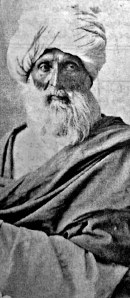
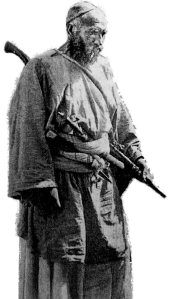
 Khattak - The Tribe of Manasseh
Khattak - The Tribe of Manasseh